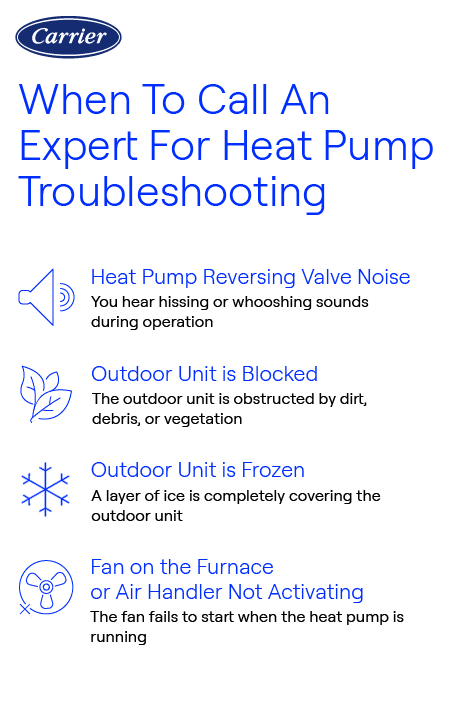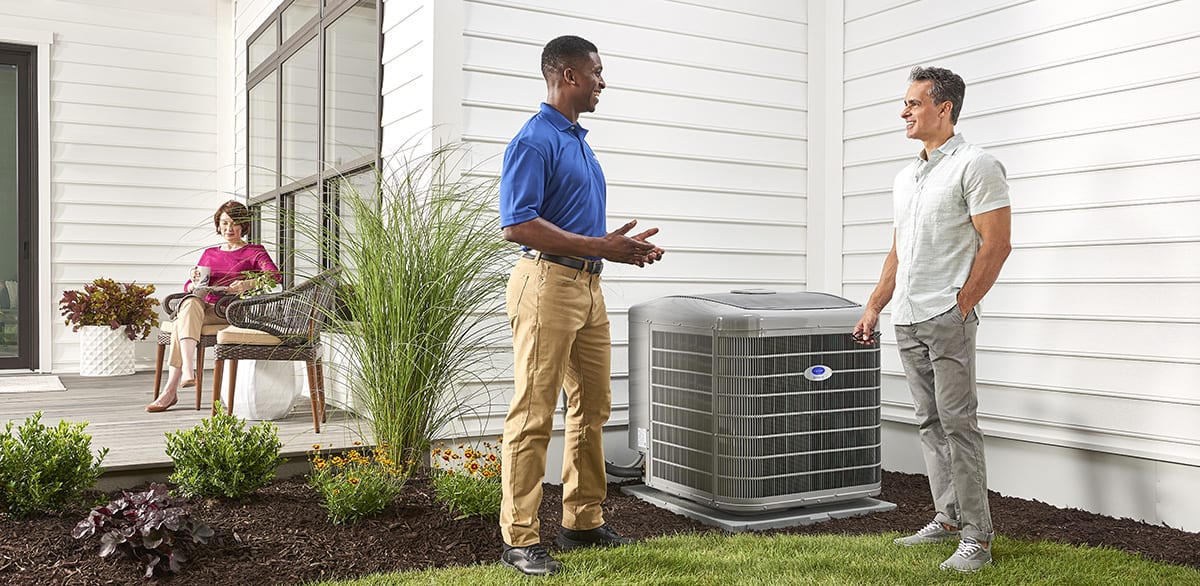Heat Pump Troubleshooting Guide: Is Your Heat Pump Not Working?
Read through the information that follows about common problems with heat pumps and do a little leg work before you contact your local HVAC technician for a heat pump service call. You just might save a little money!
Common Heat Pump Problems & Troubleshooting Tips
Your heat pump operates just like a central air conditioner with the added benefit of providing heat for your home during the winter season. Some of the common issues covered in this heat pump troubleshooting guide include:
- Blowing cold air in heat mode
- Heat pump running constantly in moderate weather
- Outdoor unit is blocked
- Outdoor unit is frozen
- Fan on the indoor air handler not activating
Heat Pump Blowing Cold Air in Heat Mode
If your heat pump system has cold air blowing or room temperature air while the thermostat is set for heat mode, there are a few common situations you can resolve without even looking at heat pump itself.
Check for a faulty thermostat - Double check that the system didn’t accidentally get set for cooling. Also check your fan control settings. If you like to run your fan continuously for air circulation and filtering, you may be feeling room temperature or cool air because the system isn’t actively heating. Re-setting the system to heat mode and the fan to auto mode should solve these issues.
If checking the thermostat doesn’t solve the problem, and your system still isn’t heating and cooling correctly, you’ll need to start looking more closely at the indoor and outdoor units as outlined below. For additional suggestions, check out our heat pump not heating page.
Heat Pump Running Constantly in Moderate Weather
Because your heat pump relies on heating energy from outdoor air, it can be completely normal for a unit to run all the time in extreme temperatures as it tries to extract enough heat for your home. But if the temperature outside is moderately warm, and the unit is still struggling or constantly running, it’s time to do a little heat pump troubleshooting.
- Check your thermostat – Begin by checking the thermostat settings. Is the heat pump set on air conditioning mode? If so, changing to the heat setting should fix the problem.
- System tune-up – If it’s not a thermostat setting, your heat pump may need a tune-up. Having your heat pump serviced regularly by a professional, qualified HVAC technician can provide higher efficiency operation and more reliable comfort. One service typically offered during routine maintenance is cleaning your outdoor coil. If the coil is extremely dirty, your system may have trouble keeping up with heating demand.
- Clean/replace air filter – Another service your HVAC tech may perform is checking the air filter located in or near your indoor air handler unit. If the air filter is dirty or clogged, it can cause the system to run longer and less effectively. It should be cleaned or replaced. This is something you can easily do yourself as well. Learn more about how often to change air filters and how to replace air filters.
- More serious issues – However, if it is mildly cold outside, the unit has been serviced recently and it is running constantly, you may have a deeper issue such as:
- Frozen coil
- Malfunctioning reversing valve
- Refrigerant levels are low
- Compressor issue
For each of these situations, it is generally best to contact a professional for diagnosis and heat pump repair.
WHEN TO CALL AN EXPERT FOR HEAT PUMP TROUBLESHOOTING

If you have already taken the necessary steps of checking your thermostat setting and ensuring that your air filter is clean, but you are still facing issues with your heat pump, it may be time to seek assistance from a local expert. Calling a professional technician can provide you with the expertise needed to troubleshoot and diagnose the problem accurately. Carrier experts have the knowledge and experience to identify potential underlying issues that may not be obvious to the average homeowner. By reaching out to a Carrier local expert, you can have peace of mind knowing that your heat pump will be properly evaluated and repaired, restoring comfort to your home.
HEAT PUMP REVERSING VALVE NOISE
If you notice a gentle, whooshing sound coming from your heat pump reversing valve, there's no need to worry. This sound is typically normal and indicates that the valve is operating as it should. The reversing valve is responsible for changing the direction of refrigerant flow, allowing your heat pump to switch between heating and cooling modes. However, if you begin to hear excessively loud or constant noises emanating from the reversing valve, it may be a cause for concern. In such cases, it's advisable to contact a local Carrier expert, as it could indicate an underlying issue that requires attention and repair.
Outdoor Unit is Blocked
Your heat pump system needs unrestricted air flow through the outdoor coil to work efficiently and effectively. If your system is not heating effectively or if it is running constantly, check the outdoor unit for excessive debris such as leaves or snow blockages. If the unit is blocked or obstructed in any way, remove the source of the blockage, then resume monitoring the temperature inside. If you still have issues, and have followed the remaining troubleshooting tips, it’s time to contact a professional. Remember, fixing a smaller issue now is better than waiting for a bigger issue – and bigger bill – later.
Outdoor Unit is Frozen
Another possible issue is having your outdoor unit frozen over. During winter, it’s normal for a little frost to develop on the outdoor coil, but a coating of ice indicates an issue. Ice on the coil impedes airflow and greatly reduces its effectiveness. A frozen coil during the summer months is also suspicious. Regardless of the season, a frozen coil can be the source of your heat pump problems and can happen for a number of reasons.
- Low refrigerant charge – If your system is low on refrigerant, it can’t produce enough heat to melt ice buildup during winter. During the summer, it’s probably the reason your indoor coil has frozen, and in either case, the heat pump has to work extra hard to keep you comfortable. Testing and charging the system is a job for a qualified HVAC technician.
- Water on outdoor unit – During the winter, water from melting snow or ice can leak onto the coil and then freeze. Your system has a defrost mode, but it may not be enough to take care of a severe freeze-over. To remedy this, find the source of the water, such as a leaky gutter, and repair the leak. Never try to chip ice from the coil. If the unit doesn’t defrost with its defrost function, call your local Carrier dealer.
- Defective fan motor – In your outdoor unit, the fan draws air through the coil, assisting in the heat transfer process vital to both heating and cooling your home. A defective fan motor means little or no airflow which can cause the coil to freeze over. This is another job for a pro.
- Malfunctioning defrost timer – The defrost mode on your heat pump is designed to kick on at pre-determined intervals to keep the outdoor unit free from icy buildup. If the timer malfunctions, your outdoor unit may not defrost as needed and freeze over. Diagnosis and remedy are best handled by a certified HVAC tech.
Fan on the Furnace or Air Handler Not Activating
If your outdoor unit is running, but you don’t feel any air coming from the registers, your indoor air handler may not be activating. Heat pump troubleshooting for common problems that can cause your indoor unit to not kick on include looking for:
- Circuit breaker tripped – Your indoor and outdoor units are on separate breakers. If your indoor air handler isn’t turning on, check your home’s electrical panel for a tripped circuit breaker. Follow standard safety precautions to reset the breaker. If it continues to trip, contact a professional.
- Bad wiring connection – A malfunctioning air handler may be the result of a burnt out or disconnected wire. Contact your local Carrier dealer to diagnose and repair.
- Blown blower motor – If the blower motor is burnt out, contact a trusted, local HVAC technician to thoroughly check your system, determine why the motor is blown, and estimate repair and replacement costs.
As you can see, heat pump problems aren’t always connected to the outdoor unit.

Find an Expert for Advanced Heat Pump Problems Troubleshooting
While there are a number of simple remedies for solving heat pump problems, many issues are best diagnosed and addressed by a qualified Carrier HVAC dealer. The sooner you resolve the issue, the sooner you and your family can enjoy the comfort and get to your daily routines.
Frequently Asked Questions About Heat Pump Troubleshooting
Several issues could cause your heat pump to be running but not heating. Check out our heat pump not heating page to learn more
Learn More About Heat Pump Troubleshooting
- Find out “how does a heat pump work?”
- Let's start with the basics - what is a heat pump?
- Learn about heat pump efficiency ratings
- Discover heat pump tax credits
- Learn about heat pump installation
- Discover if you need a 3 ton heat pump


